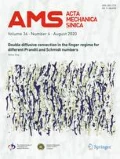Abstract
Driven by curiosity about possible flight options for the Chang’e-2 spacecraft after it remains at the Sun-Earth L2 point, effective approaches were developed for designing preliminary fuel-optimal near-Earth asteroid flyby trajectories. The approaches include the use of modified unstable manifolds, grid search of the manifolds’ parameters, and a two-impulse maneuver for orbital phase matching and z-axis bias change, and are demonstrated to be effective in asteroid target screening and trajectory optimization. Asteroid flybys are expected to be within a distance of 2 × 107 km from the Earth owing to the constrained Earth-spacecraft communication range. In this case, the spacecraft’s orbital motion is significantly affected by the gravities of both the Sun and the Earth, and therefore, the concept of the “heliocentric oscillating-Kepler orbit” is proposed, because the classical orbital elements of the flyby trajectories referenced in the heliocentric inertial frame oscillate significantly with respect to time. The analysis and results presented in this study show that, among the asteroids whose orbits are the most accurately predicted, “Toutatis”, “2005 NZ6”, or “2010 CL19” might be encountered by Chang’e-2 in late 2012 or 2013 with total impulses less than 100m/s.
Similar content being viewed by others
References
Gao, Y., Li, H., He, S.: First-round design of the flight scenario for Chang’e-2’s extended mission: takeoff from lunar orbit. Acta Mechanica Sinica 28, 1466–1478 (2012)
Farquhar, R.: Mission design for a halo orbiter of the Earth. Journal of Spacecraft and Rockets 14, 170–177 (1977)
Belbruno, E.: Capture Dynamics and Chaotic Motions in Celestial Mechanics with Applications to the Construction of Low Energy Transfers. Princeton University Press, Princeton (2004)
Lo, M., Ross, S.D.: Low energy interplanetary transfers using invariant manifolds of L1 and L2 and halo orbits. In: Proceedings of AAS/AIAA Space Flight Mechanics Meeting, Monterey, California, Feb 9–11 (1998)
Koon, W.S., Lo, M.W., Marsden, J.E.: Heteroclinic connections between periodic orbits and resonance transitions in celestial mechanics. Chaos 10, 427–469 (2000)
Gomez, G., Koon, W.S., Lo, M.E.: Invariant manifolds, the spatial three-body problem and space mission design. In: Proceedings of AAS-01-301, AAS/AIAA Astrodynamics Specialist Conference, Quebec City, Canada (2001)
Gomez, G., Jorba, A., Masdemont, J.: Study of the transfer from the Earth to a halo orbit around the equilibrium point L1, Celestial Mechanics and Dynamical Astronomy 56, 541–562, (1993)
Howell, K., Mains, D., Barden, B.: Transfer trajectories from Earth parking orbits to Sun-Earth halo orbits. Advances in the Astronautical Sciences 87, 399–422 (1994)
Senent, J., Ocampo, C., Capella, A.: Low-thrust variable specific-impulse transfers and guidance to unstable periodic orbits. Journal of Guidance, Control, and Dynamics 28, 280–290 (2005)
Mingotti, G., Topputo, F., Bernelli-Zazzera, F.: Combined optimal low-thrust and stable-manifold trajectories to the Earth-Moon halo orbits. New Trends in Astrodynamics and Applications 3886, 100–112 (2007)
Howell, K.C, Kakoi, K.: Transfers between the Earth-Moon and Sun-Earth systems using manifolds and transit orbits. Acta Astronautica 59, 367–380 (2006)
JPL DE405 Ephemeris. ftp://ssd.jpl.nasa.gov/pub/eph/export/usrguide (2012)
Szebehely, V.: Theory of Orbits: The Restricted Problem of Three Bodies. Academic Press, New York (1967)
Richardson, D.L.: Analytic construction of periodic orbits about the collinear point. Celestial Mechanics 22, 241–253 (1980)
Ozimek, M.T., Howell, K.C.: Low-thrust transfers in the Earth-Moon system, including applications to libration point orbit. Journal of Guidance, Control, and Dynamics 33, 533–549 (2010)
Battin, R.H.: An Introduction to the Mathematics and Methods of Astrodynamics. American Institute of Aeronautics and Astonautics, Inc., New York (1987)
NEO Earth close-approaches. http://neo.jpl.nasa.gov/cgibin/neo_ca (2012)
JPL small-body data browser. http://ssd.jpl.nasa.gov/sbdb.cgi (2012)
Catalogue of the solar system small bodies’ orbital evolution. http://smallbodies.ru/en (2012)
Bazaraa, M.S., Sherali, H.D., Shetty, C.M.: Nonlinear Programming Theory and Algorithm. John Wiley & Sons Inc., USA (1993)
Author information
Authors and Affiliations
Corresponding author
Additional information
The project was supported by the State Key Laboratory of Astronautic Dynamics (2011ADL-DW0202).
Rights and permissions
About this article
Cite this article
Gao, Y. Near-Earth asteroid flyby trajectories from the Sun-Earth L2 for Chang’e-2’s extended flight. Acta Mech Sin 29, 123–131 (2013). https://doi.org/10.1007/s10409-013-0011-8
Received:
Revised:
Accepted:
Published:
Issue Date:
DOI: https://doi.org/10.1007/s10409-013-0011-8




